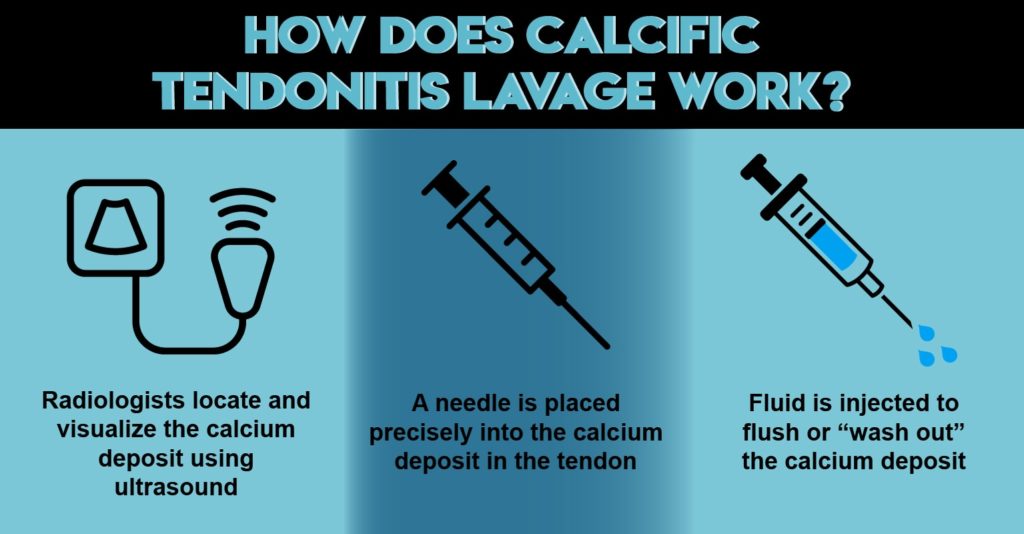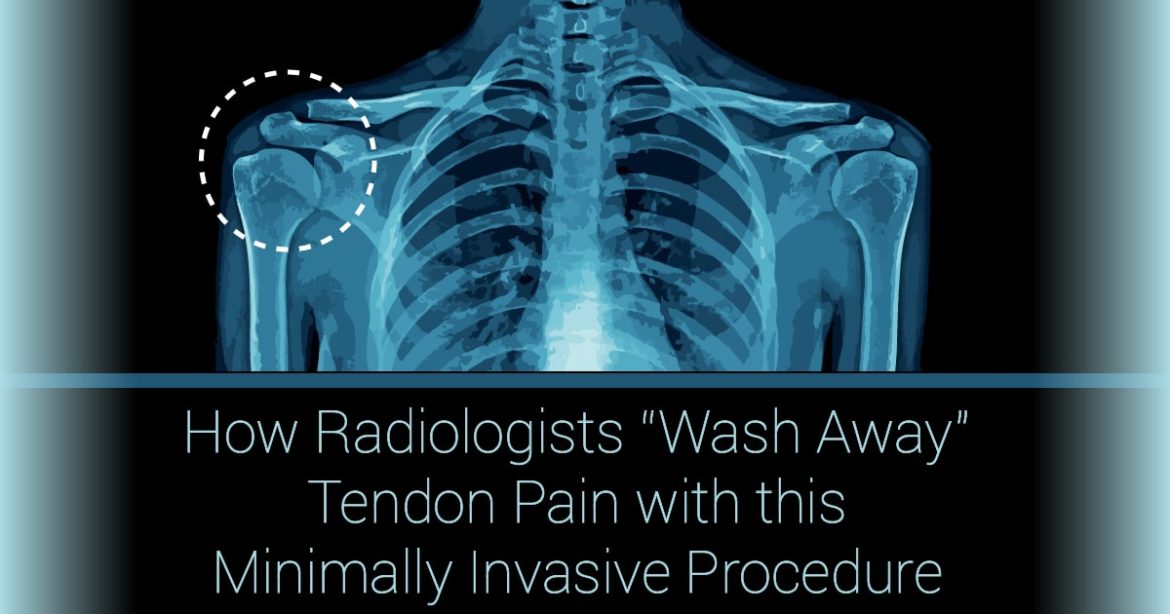Do you experience frequent pain when lifting anything overhead or playing sports that require overhead motion? Tendon pain can be caused by a variety of issues, one of these being a calcium deposit that has formed in your tendon after an injury. At UVA Radiology, we want you to know that surgery is not your only option for this type of tendon pain. We provide a minimally invasive treatment called Calcific Tendonitis Lavage to “wash away” calcium deposits so that you can get moving without pain.
Article Reviewed by Dr. Jennifer Pierce and Dr. Nicholas Nacey
What is Calcific Tendonitis?
Calcific Tendonitis is a condition that causes small calcium deposits to form in tendons- the cords of tissue in your joints that attach your muscles to your bones. Calcium is an essential mineral in the body, primarily found in the hardest substances of the body like the bones and teeth. During the healing process after a tendon injury or degeneration, calcium can form in the tendons. These deposits vary in firmness as they develop, from a soft paste-like substance to a firm bone-like material.
Calcific Tendonitis can occur in any tendon within the body, but has been known to primarily form in the shoulder rotator cuff– the group of tendons that help raise the arm. Calcium deposits cause inflammation and induce moderate to severe pain with movement of the tendons depending on the placement, firmness, and size of the deposit.
Risk Factors
While the precise cause of calcific tendonitis is unknown, it primarily affects those who do a lot of activity that includes overhead motion, such as heavy lifting or playing sports like tennis or basketball. Calcific tendonitis most commonly occurs in females between the ages of 35 and 65, but can sometimes occur in males as well.
Symptoms
While calcific tendonitis is relatively common, not ALL shoulder pain is due to calcific tendonitis. Symptoms usually begin to occur when the calcium deposit is large enough to be noticed while moving. These symptoms may include:
- Pain when moving the affected area
- Restricted range of motion
- Moderate to severe discomfort (some people feel unable to move arm)
If you experience unusual or persistent pain in a joint, you should see your primary care doctor or an orthopedic sub-specialist.
Diagnosis
First, your doctor will ask you about your symptoms and look over your medical history before performing a physical exam. When conducting a physical exam, they may then ask you to lift your arm or make arm circles (or move any affected joints). This will help your doctor to understand where the pain is occurring and any limitations in your range of motion.
Your doctor will then order some imaging tests to look for any calcium deposits or other abnormalities. Most likely X-rays will be used to produce images in which the calcium deposit can be easily seen.
Knowing Your Options
Conservative treatment for mild cases of calcific tendonitis start with over-the-counter anti-inflammatory drugs and physical therapy. If the calcific tendonitis is more severe and causes significant pain, other treatment options include:
1)Surgery (open surgery or arthroscopic)– Open surgery is when a large incision is made to directly remove the calcium. Arthroscopic surgery is when a few small incisions are made to insert a small camera and instruments. The camera helps the doctors see inside and guide their instruments to remove the calcium deposits.
2) Ultrasound-guided needle lavage (or Calcific Tendonitis Lavage)– Lavage means to irrigate or “wash out” with fluid, in this case the calcium deposit. Using ultrasound, the calcium deposits are visualized and a needle can be placed precisely into the tendon to flush or “wash out” the calcium with fluid. This needle based procedure is significantly less invasive than either open or arthroscopic surgery.

Advantages of Ultrasound-Guided Needle Lavage
Any time a condition is able to be treated without making incisions in the body, this minimizes the risk of complications or infections and speeds up the recovery time a patient must endure. UVA radiologists are able to treat calcium deposits with ultrasound-guided needle lavage as a less-invasive, safe, and effective procedure. Patients are asked to rest for 48 hours and avoid heavy lifting for two weeks, but will be able to resume normal daily activities quickly.
If you have been diagnosed with calcific tendonitis, talk to your doctor about calcific tendonitis lavage as a treatment option or call 434.243.0321 to schedule a consultation with a UVA Radiologist. You can also call UVA Musculoskeletal Radiology directly at 434.243.0391.
Do you suffer from tennis elbow, plantar fasciitis, or some other nagging tendon pain? Click here to learn about Tenex – a minimally invasive, non-surgical treatment for chronic tendon pain.



